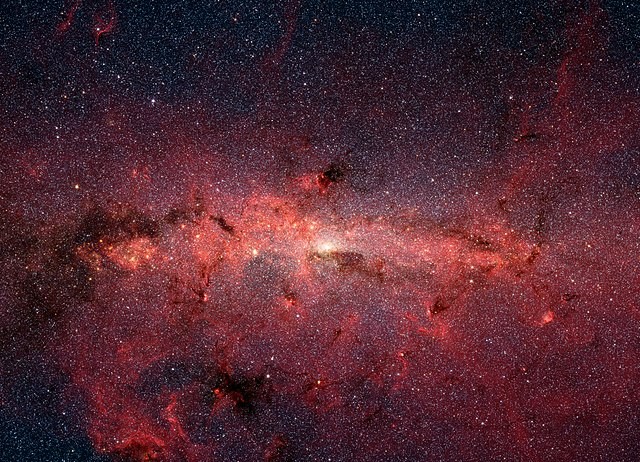
(Photo: Wikimedia Commons/NASA/JPL-Caltech/S. Stolovy (Spitzer Science Center/Caltech))
Researchers use Gaia to study the Milky Way. They recently found two components that could be among the earliest building blocks of our galaxy.
Earliest Building Blocks of the Milky Way Discovered
The Milky Way, our home galaxy, was formed by the merger of smaller galaxies in its early history, which resulted in some very big construction components. In a new study, the Max Planck Institute for Astronomy's Khyati Malhan and Hans-Walter Rix have now identified what may be two of the earliest building blocks that are still identifiable as such -- proto-galactic fragments that combined with an early Milky Way between 12 and 13 billion years ago, at the very beginning of the universe's galaxy formation era.
The components were detected by merging data from the SDSS survey with data from ESA's astrometry satellite Gaia. The astronomers have called these components Shakti and Shiva.
Malhan and Rix employed the Sloan Digital Sky Survey's (DR17) comprehensive star spectra in conjunction with Gaia data. The latter gives specific details regarding the chemical makeup of the stars.
"We observed that, for a certain range of metal-poor stars, stars were crowded around two specific combinations of energy and angular momentum," per Malhan.
Unlike the "poor old heart," evident in those plots, the two clusters of like-minded stars had large angular momentum, correlating with groups of stars that had been part of other galaxies that had merged with the Milky Way. Malhan refers to these two formations as Shakti and Shiva; the former is a cosmic feminine force that is often portrayed as Shiva's consort, while the latter is one of the principal deities in Hinduism.
Due to their similarity to the "poor old heart" in terms of metallicity and their energy and angular momentum values, Shakti and Shiva are intriguing candidates for some of the early Milky Way's progenitors.
"Shakti and Shiva might be the first two additions to the 'poor old heart' of our Milky Way, initiating its growth towards a large galaxy," Rix said.
For astronomers, the outcome is akin to discovering remnants of a prehistoric civilization that expanded into a sizable modern city. Numerous ongoing or soon-to-be-starting surveys offer pertinent extra data. These include precise distances (LSST/Rubin Observatory) and spectra (SDSS-V, 4MOST), which should help astronomers decide whether or not Shakti and Shiva represent a glimpse of the earliest prehistory of our home galaxy.
ALSO READ: Japan to Launch Mug-Sized Wooden Satellite to Reduce Space Pollution
Cosmic Serpent in the Milky Way
Scientists discovered a gigantic, wave-shaped structure a few years ago that stretched about 9,000 light-years along a Milky Way spiral arm. At its closest stage, the structure was barely 500 light-years away from the Solar System.
The Radcliffe Wave, a squiggle of star-forming gas, is a remarkable discovery, and there is still more to learn. However, Harvard University astronomer Ralf Konietzka and his scientific team recently revealed one thing: the Radcliffe Wave, like many other Milky Way objects, is in motion.
Its motion is not limited to a simple rotation around the galaxy's center. An oscillating periodic traveling wave is known as a Radcliffe wave.
RELATED ARTICLE: Will The Sun Explode 5 Billion Years From Now? Probably, Experts Say!
Check out more news and information on Space in Science Times.


![Earth's Quasi-Moon Kamo‘oalewa Could Originate From Lunar Surface Not Asteroid Belt [Study]](https://1721181113.rsc.cdn77.org/data/thumbs/full/53275/89/56/50/40/earths-quasi-moon-kamo-oalewa-could-originate-from-lunar-surface-not-asteroid-belt-study.png)











